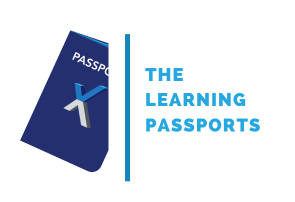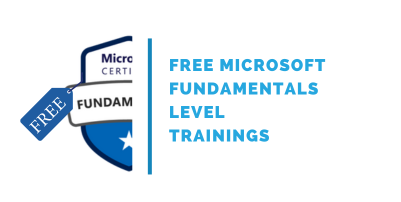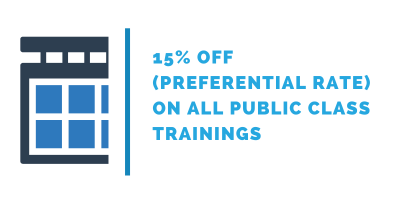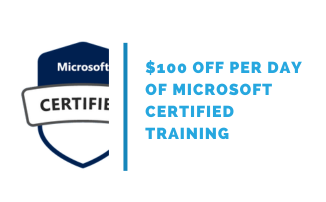
Microsoft Certified: Azure Administrator Associate (AZ104)

Microsoft AZ-104, also known as the Azure Administrator Associate certification, is a pivotal course designed to empower individuals with comprehensive knowledge of Azure Administration. This Microsoft certified course teaches IT Professionals how to manage their Azure subscriptions, secure identities, administer the infrastructure, configure virtual networking, connect Azure and on-premises sites, manage network traffic, implement storage solutions, create and scale virtual machines, implement web apps and containers, back up and share data, and monitor your solution.
This training is a comprehensive preparation for the AZ-104: Microsoft Azure Administrator exam for obtaining the Microsoft Certified: Azure Administrator Associate certification.

Public class
2375$
Duration:
4 days / 28 hours
Private class
Virtual classroom
Minimum no. of participants: 5
4 days / 28 hours
Price on request
English or French
Training plan:
Microsoft Azure Administrator (AZ-104T00)
Module 1: Configure Microsoft Entra ID
- Describe Microsoft Entra ID benefits and features
- Describe Microsoft Entra ID concepts
- Compare Active Directory Domain Services to Microsoft Entra ID
- Select Microsoft Entra ID editions
- Implement Microsoft Entra ID join
- Implement Microsoft Entra ID self-service password reset
Module 2: Configure user and group accounts
- Create user accounts
- Manage user accounts
- Create bulk user accounts
- Create group accounts
- Create administrative units
Module 3: Configure subscriptions
- Identify Azure regions
- Implement Azure subscriptions
- Obtain an Azure subscription
- Identify Azure subscription usage
- Implement Microsoft Cost Management
- Apply resource tagging
- Apply cost savings
Module 4: Configure Azure Policy
- Create management groups
- Implement Azure policies
- Create Azure policies
- Create policy definitions
- Create an initiative definition
- Scope the initiative definition
- Determine compliance
Module 5: Configure role-based access control
- Implement role-based access control
- Create a role definition
- Create a role assignment
- Compare Azure roles to Microsoft Entra ID roles
- Apply role-based access control
- Review fundamental Azure RBAC roles
Module 6: Configure Azure resources with tools
- Use the Azure portal
- Use Azure Cloud Shell
- Use Azure PowerShell
- Interactive lab simulation (Azure PowerShell)
- Use Azure CLI
Module 7: Use Azure Resource Manager
- Review Azure Resource Manager benefits
- Review Azure resource terminology
- Create resource groups
- Create Azure Resource Manager locks
- Reorganize Azure resources
- Remove resources and resource groups
- Determine resource limits
Module 8: Configure resources with Azure Resource Manager templates
- Review Azure Resource Manager template advantages
- Explore the Azure Resource Manager template schema
- Explore the Azure Resource Manager template parameters
- Consider Bicep templates
- Review QuickStart templates
Module 9: Configure virtual networks
- Plan virtual networks
- Create subnets
- Create virtual networks
- Plan IP addressing
- Create public IP addressing
- Associate public IP addresses
- Associate private IP addresses
Module 10: Configure network security groups
- Implement network security groups
- Determine network security group rules
- Determine network security group effective rules
- Create network security group rules
- Implement application security groups
Module 11: Configure Azure DNS
- Identify domains and custom domains
- Verify custom domain names
- Create Azure DNS zones
- Delegate DNS domains
- Add DNS record sets
- Plan for Azure Private DNS zones
- Review Azure Private DNS zone scenarios
Module 12: Configure Azure Virtual Network peering
- Determine Azure Virtual Network peering uses
- Determine gateway transit and connectivity
- Create virtual network peering
- Extend peering with user-defined routes and service chaining
Module 13: Configure network routing and endpoints
- Review system routes
- Identify user-defined routes
- Determine service endpoint uses
- Determine service endpoint services
- Identify private link uses
Module 14: Configure Azure Load Balancer
- Determine Azure Load Balancer uses
- Implement a public load balancer
- Implement an internal load balancer
- Determine load balancer SKUs
- Create back-end pools
- Create health probes
- Create load balancer rules
Module 15: Configure Azure Application Gateway
- Implement Azure Application Gateway
- Determine Azure Application Gateway routing
- Configure Azure Application Gateway components
Module 16: Configure storage accounts
- Implement Azure Storage
- Explore Azure Storage services
- Determine storage account types
- Determine replication strategies
- Access storage
- Secure storage endpoints
Module 17: Configure Azure Blob Storage
- Implement Azure Blob Storage
- Create blob containers
- Assign blob access tiers
- Add blob lifecycle management rules
- Determine blob object replication
- Upload blobs
- Determine Blob Storage pricing
Module 18: Configure Azure Storage security
- Review Azure Storage security strategies
- Create shared access signatures
- Identify URI and SAS parameters
- Determine Azure Storage encryption
- Create customer-managed keys
- Apply Azure Storage security best practices
Module 19: Configure Azure Files and Azure File Sync
- Compare storage for file shares and blob data
- Manage Azure Files shares
- Create file share snapshots
- Implement Azure File Sync
- Identify Azure File Sync components
- Deploy Azure File Sync
Module 20: Configure Azure Storage with tools
- Use Azure Storage Explorer
- Use the Azure Import/Export service
- Use the WAImportExport tool
- Use the AzCopy tool
Module 21: Configure virtual machines
- Review cloud services responsibilities
- Plan virtual machines
- Determine virtual machine sizing
- Determine virtual machine storage
- Create virtual machines in the Azure portal
- Connect to virtual machines
Module 22: Configure virtual machine availability
- Plan for maintenance and downtime
- Create availability sets
- Review update domains and fault domains
- Review availability zones
- Compare vertical and horizontal scaling
- Implement Azure Virtual Machine Scale Sets
- Create Virtual Machine Scale Sets
- Implement autoscale
- Configure autoscale
Module 23: Configure Azure App Service plans
- Implement Azure App Service plans
- Determine Azure App Service plan pricing
- Scale up and scale out Azure App Service
- Configure Azure App Service autoscale
Module 24: Configure Azure App Service
- Implement Azure App Service
- Create an app with App Service
- Explore continuous integration and deployment
- Create deployment slots
- Add deployment slots
- Secure your App Service app
- Create custom domain names
- Back up and restore your App Service app
- Use Azure Application Insights
Module 25: Configure Azure Container Instances
- Compare containers to virtual machines
- Review Azure Container Instances
- Implement container groups
- Review the Docker platform
Module 26: Configure Azure Kubernetes Service
- Explore Azure Kubernetes Service terminology
- Explore the AKS cluster and node architecture
- Configure Azure Kubernetes Service networking
- Configure Azure Kubernetes Service storage
- Configure Azure Kubernetes Service scaling
- Configure AKS burst scaling to Azure Container Instances
Module 27: Configure file and folder backups
- Describe Azure Backup benefits
- Implement Backup center for Azure Backup
- Configure Azure Recovery Services vault backup options
- Use the Microsoft Azure Recovery Services (MARS) agent
- Configure on-premises file and folder backups
Module 28: Configure virtual machine backups
- Protect virtual machine data
- Create virtual machine snapshots
- Setup recovery services vault backup options
- Backup virtual machines
- Restore virtual machines
- Implement Azure Backup Server
- Compare backup options
- Manage soft delete
- Implement Azure Site Recovery
Module 29: Configure Azure Monitor
- Describe Azure Monitor key capabilities
- Describe Azure Monitor components
- Define metrics and logs
- Identify data types
- Describe activity log events
- Query the activity log
Module 30: Configure Azure alerts
- Manage Azure Monitor alerts
- Create alert rules
- Create action groups
Module 31: Configure Log Analytics
- Determine Log Analytics uses
- Create a workspace
- Visualize Log Analytics data
- Structure Log Analytics queries
Module 32: Configure Network Watcher
- Describe Network Watcher features
- Review flow verify diagnostics
- Review next hop diagnostics
- Visualize the network topology
Exclusives:
- One FREE attendance to the Microsoft Certified: Security, Compliance, and Identity Fundamentals (SC900) training - $695 value!
- One voucher to take the exam - $225 value!
- One year access to the class recording
- 180 days access to the lab environment after class
- Up to date courseware with Microsoft Learn
- Microsoft course achievement badge
Prerequisites:
Understanding of on-premises virtualization technologies, including: VMs, virtual networking, and virtual hard disks.
Understanding of network configuration, including TCP/IP, Domain Name System (DNS), virtual private networks (VPNs), firewalls, and encryption technologies.
Understanding of Active Directory concepts, including users, groups, and role-based access control.
Understanding of resilience and disaster recovery, including backup and restore operations.
Credentials information:
Exam Characteristics
- Exam code: AZ-104
- Exam Title: Microsoft Azure Administrator
- Exam Duration: 120 minutes
- Number of Questions: 40 to 60
- Questions Format: Multiple-choice, multiple-answer, scenario-based
- Passing Score: 700 out of 1000
- Cost: $0 (included in your training)
Exam Topics
- Manage Azure identities and governance
- Implement and manage storage
- Deploy and manage Azure compute resources
- Implement and manage virtual networking
- Monitor and maintain Azure resources
- All details...
Follow-on trainings:
Audiences:
Eccentrix Corner writing/whitepaper:
Overview of AZ-104: Microsoft Azure Administrator
AZ-104, Microsoft Azure Administrator, focuses on equipping individuals with the skills necessary to manage Azure subscriptions, secure resources, implement storage solutions, configure virtual networking, and administer Azure identities.
Importance and Objectives
The significance of AZ-104 lies in its role as a foundational course for individuals aspiring to become proficient Azure Administrators. It aims to impart essential knowledge and hands-on experience in handling various Azure services and resources efficiently.
Scope and Target Audience
The scope of AZ-104 encompasses a broad range of Azure administration topics, making it suitable for IT professionals, administrators, or anyone looking to enhance their expertise in Azure management. The course doesn't demand extensive prior experience, allowing individuals from diverse backgrounds to grasp Azure's fundamental concepts.
Exam Preparation
Preparing for the AZ-104 exam requires a systematic approach. Microsoft offers learning paths, study materials, and practice tests to help candidates familiarize themselves with the exam topics. Hands-on experience with Azure services, exploring Azure functionalities, and understanding the basics of administration are vital for effective exam readiness.
AZ-104 Learning Resources
Microsoft Learn provides a structured learning path for AZ-104, offering modules covering Azure administration fundamentals, practical labs, and their applications. Additionally, practice tests, study guides, and relevant documentation are available to aid in exam preparation.
AZ-104 vs AZ-204
While AZ-104 focuses on Azure administration, AZ-204 concentrates on developing solutions using Azure. Both certifications cater to different roles within the Azure ecosystem.
AZ-104 vs AZ-900
AZ-104 is tailored for Azure administrators, whereas AZ-900 is an introductory course providing a broader understanding of Azure services.
Conclusion
In summary, the AZ-104 Microsoft course is an essential steppingstone for individuals seeking to excel in Azure administration. Its comprehensive coverage of Azure services and management, coupled with practical applications, makes it a valuable certification for those aiming to become proficient Azure Administrators.
Common Questions about AZ-104 (FAQ)
Is the AZ-104 exam hard?
The difficulty level of the AZ-104 exam varies based on an individual's experience and preparation. It covers fundamental to intermediate Azure administration topics. Adequate preparation and hands-on experience with Azure services can significantly aid in achieving success in the exam.
Is AZ-104 considered an entry-level certification?
While AZ-104 covers fundamental Azure administration concepts, it's typically not classified as an entry-level certification. It's designed for individuals already familiar with Azure fundamentals or have prior experience in Azure administration.
Do I need to complete AZ-900 before taking AZ-104?
AZ-900 is not a prerequisite for AZ-104. AZ-900 focuses on Azure basics and fundamentals, whereas AZ-104 delves into Azure administration. However, having a foundational understanding of Azure concepts from AZ-900 can be beneficial but is not mandatory.
Is AZ-104 sufficient to land a job in Azure administration?
AZ-104 certification validates your expertise in Azure administration, making you eligible for Azure administration roles. However, job requirements often vary, and employers may seek additional skills or experience alongside the certification for specific roles.
Contact us for more information on pricing::
Eccentrix
Office: 1-888-718-9732
E-mail: info@eccentrix.ca
130, King Street West, Suite 1800
Toronto, Ontario M5X 1E3
www.eccentrix.ca









